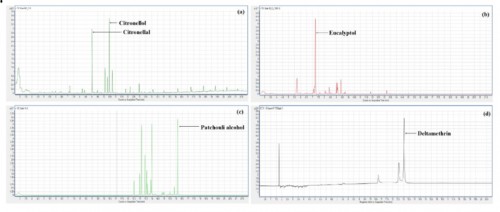Toxicity of essential oils on Aedes aegypti: A vector of chikungunya and dengue fever
Author(s): Hemanga Hazarika, Varun Tyagi, Harshita Krishnatreyya, Sumit Kishor, Sanjeev Karmakar, Dibya Ranjan Bhattacharyya, Kamaruz Zaman and Pronobesh Chattopadhyay
Abstract: Vector-borne diseases such as chikungunya, dengue, encephalitis, filariasis, and malaria pose an enormous menace to humans. Use of larvicidal strategies acting against the immature stages of mosquitoes might be useful in combating these diseases. The available synthetic insecticides have serious side effects, are toxic to the environment and the insects probably have higher chances of developing resistance against them. As compared to synthetic pesticides, essential oils (EOs) are ecologically safe, have no mammalian toxicity or the chances of development of resistance are reasonable and highly popular with the organic growers. In the present investigation, we have studied the larvicidal properties of four different concentrations (10, 50, 100 and 500 mg/l) of 3 essential oils (EOs), namely, citronella (Cympobogon nardus), eucalyptus (Eucalyptus globulus), and patchouli (Pogostemon cablin) against the larval stage of Aedes aegypti mosquitoes. Biochemical and histopathological changes in the Aedes aegypti larvae after exposure to essential oils were studied. Essential oils were analyzed by gas chromatography-mass spectrometry (GC-MS) for chemical compositions. The highest larvicidal activity was observed in the EOs from patchouli oil against the larvae of Aedes aegypti with LC50 (lethal concentration required to kill 50% of the population) value 25.14 mg/l respectively. LC50 values for citronella, eucalyptus and patchouli oils were found to be 38.37, 51.93, 25.14 mg/l respectively. Glucose, total protein and urea levels were misbalanced in the larvae after oil exposure. A serious damage in brush border, digestive cells, basal membrane, epithelium, and peritrophic membrane in the mid gut of the essential oil treated larvae were observed under histopathological study. The major aromatic compounds identified by the GC-MS were linalool, citronellol, citronellal and β-Citral in citronella oil; eucalyptol, d-pinene, and o-cymene in eucalyptus oil; patchouli alcohol and seychellene in patchouli oil respectively. A concentration-dependent larvicidal effect was shown by the EOs against Aedes aegypti larva. The aromatic compounds identified in the EOs triggered significant responses in mortality. EOs can be applied as green pesticide which could be effective to control the vector borne diseases.
 Fig.:
Fig.: Identification of major chemical compositions by GC-MS. (a) citronella oil, (b) eucalyptus oil, (c) patchouli oil, (d) deltamethrin (positive control)
How to cite this article:
Hemanga Hazarika, Varun Tyagi, Harshita Krishnatreyya, Sumit Kishor, Sanjeev Karmakar, Dibya Ranjan Bhattacharyya, Kamaruz Zaman, Pronobesh Chattopadhyay. Toxicity of essential oils on Aedes aegypti: A vector of chikungunya and dengue fever. Int J Mosq Res 2018;5(3):51-57.



